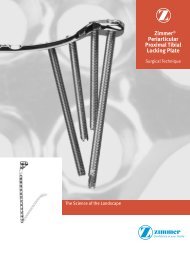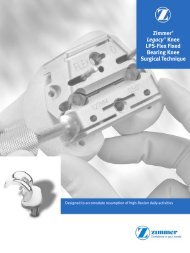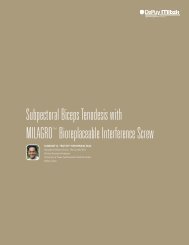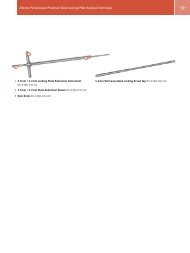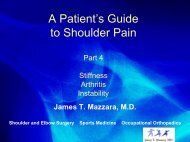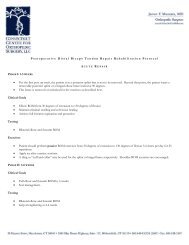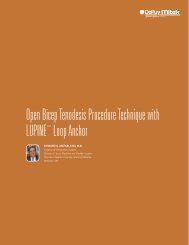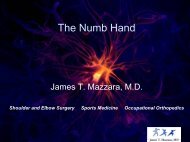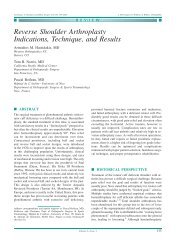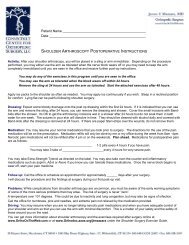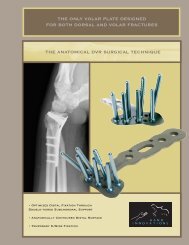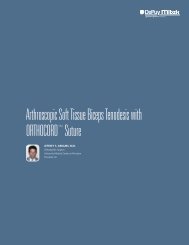Postoperative Rotator Cuff Repair Rehabilitation Protocol Large and ...
Postoperative Rotator Cuff Repair Rehabilitation Protocol Large and ...
Postoperative Rotator Cuff Repair Rehabilitation Protocol Large and ...
- No tags were found...
You also want an ePaper? Increase the reach of your titles
YUMPU automatically turns print PDFs into web optimized ePapers that Google loves.
<strong>Postoperative</strong> <strong>Rotator</strong> <strong>Cuff</strong> <strong>Repair</strong> <strong>Rehabilitation</strong> <strong>Protocol</strong><strong>Large</strong> <strong>and</strong> Massive TearsPhase I: 0-6 weeks – exercise 4-5 times per daysGoals1. Patient education2. Allow healing of tendon to bone (6 weeks regardless of repair technique)3. In certain cases, therapy may not begin until 3 weeks post op.4. Control pain <strong>and</strong> inflammation5. Initiate range of motion exercises<strong>Postoperative</strong> day 1-71. Educate patient on precautions2. Pendulum exercises3. Elbow AROM, h<strong>and</strong> squeeze exercises4. Supine PROM forward elevation in appropriate patient5. Ice (Instruct patient on use of ice at home)<strong>Postoperative</strong> day 7-101. Review precautions2. Ice3. Pendulums, elbow AROM, <strong>and</strong> h<strong>and</strong> squeezes4. Supine passive forward elevation <strong>and</strong> external rotation in plane of scapula above level of abduction pillow5. Active periscapular exercises (retraction <strong>and</strong> elevation)Phase I• Patients are discharged the day of surgery. Most patients will have an interscalene block that wears off in the 24 hoursfollowing surgery.• Ice should be encouraged as often as possible in order to reduce pain <strong>and</strong> inflammation.• Rehab begins on post-op day 1. Patients should expect swelling <strong>and</strong> discoloration in the affected arm <strong>and</strong> occasionallythe chest wall as a result of the surgery.• Patients are expected to wear their arm immobilizer with the abduction pillow for 6 weeks post op unlessspecifically directed to do otherwise by the operating surgeon. This applies whether the tendon was repairedby open, mini-open or arthroscopic technique.• Patients may often use their h<strong>and</strong> for waist level activities when tolerated.• They should be cautioned against using the shoulder for any active motion, sleeping on the surgical side, leaning on theelbow, <strong>and</strong> sudden movements.• Therapists should document distal neurovascular exam, passive arcs of forward elevation <strong>and</strong> external rotation.• Exercises should be performed for 20 repetitions 4-5 times per day. When the patient is performing home exercises,frequent shorter periods of exercises are preferred over one longer session.
<strong>Rehabilitation</strong> Guidelines for <strong>Large</strong> <strong>and</strong> Massive Tear <strong>Repair</strong>James T. Mazzara, MDPhase I (continued)• H<strong>and</strong> squeezes <strong>and</strong> active elbow ROM without weights) are encouraged.• Pendulums in tolerable ranges should be performed 25 times in each direction.• Supine passive forward elevation with the opposite h<strong>and</strong> <strong>and</strong> passive external rotationwith the arm at 45 degrees to the plane of the scapula. (or to a limit determined bythe surgeon) are started post-op days 1.• External rotation limits_______________ degrees.• Forward elevation limits_______________ degrees.• The adducted position is avoided because external rotation with the arm adducted hasbeen shown to increase tension across the repaired tissues.• Functional internal rotation is absolutely avoided since shoulder extension <strong>and</strong> internalrotation will apply excess tension to the repair <strong>and</strong> endanger the integrity of the repair.MD Notes:Phase II: 6 - 10 weeksGoals1. Discontinue sling.2. Improve to full ROM3. Improve neuromuscular control <strong>and</strong> strength4. Emphasize normal scapulohumeral rhythm5. Decreased pain <strong>and</strong> inflammationTreatment1. Continue all stretches2. Review all exercises <strong>and</strong> precautions3. AAROM (Ladder, pulley, cane)4. Add phase II stretching (internal rotation <strong>and</strong> cross body abduction)5. Scapular strengthening (Shoulder shrugs, scapular retraction)6. May progress to resisted scapular strengthening7. Submaximal rotator cuff isometrics at 6-8 weeks. MD will indicate.________8. Phase I strengthening at 6-8 weeks. To be determined by surgeon. Depends onsize of tear, ease of repair, quality of tissue. MD will indicate.__________Phase II• Passive/active-assistive ROM into ER can be performed at 70-90 degrees of POSabduction.• Supine active-assistive ROM into elevation may be started.• ROM restrictions are expected at this time with large or massive cuff tears.• After 6 weeks, AAROM in all directions is permitted with caution in internal rotation.
<strong>Rehabilitation</strong> Guidelines for <strong>Large</strong> <strong>and</strong> Massive Tear <strong>Repair</strong>James T. Mazzara, MDPhase IV: 16-26 weeksGoals1. Full functional activities2. Return to work or sports3. Promote concept of preventionTreatment1. Work or sport specific training for laborers of athletes2. Suggest modifications to work, sport, or functional activities3. Gradual return to sports or desired activityPhase IV• Gradually progress on their home strengthening program. A gradual return to overheadactivities may be permitted.Comments• Unrestricted overhead work is usually permitted after 6 months.• Most other activities may be attempted after 4 months depending on the individual patient’space of recoveryMD Notes:



